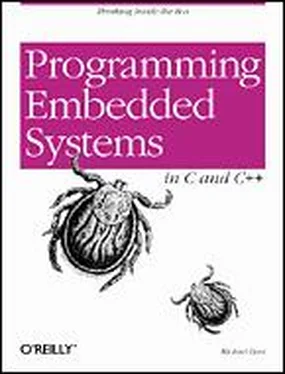Michael Barr - Programming Embedded Systems in C and C++
Здесь есть возможность читать онлайн «Michael Barr - Programming Embedded Systems in C and C++» весь текст электронной книги совершенно бесплатно (целиком полную версию без сокращений). В некоторых случаях можно слушать аудио, скачать через торрент в формате fb2 и присутствует краткое содержание. Год выпуска: 1999, ISBN: 1999, Издательство: O'Reilly, Жанр: Программирование, Компьютерное железо, на английском языке. Описание произведения, (предисловие) а так же отзывы посетителей доступны на портале библиотеки ЛибКат.
- Название:Programming Embedded Systems in C and C++
- Автор:
- Издательство:O'Reilly
- Жанр:
- Год:1999
- ISBN:1-56592-354-5
- Рейтинг книги:5 / 5. Голосов: 1
-
Избранное:Добавить в избранное
- Отзывы:
-
Ваша оценка:
- 100
- 1
- 2
- 3
- 4
- 5
Programming Embedded Systems in C and C++: краткое содержание, описание и аннотация
Предлагаем к чтению аннотацию, описание, краткое содержание или предисловие (зависит от того, что написал сам автор книги «Programming Embedded Systems in C and C++»). Если вы не нашли необходимую информацию о книге — напишите в комментариях, мы постараемся отыскать её.
Programming Embedded Systems in C and C++ — читать онлайн бесплатно полную книгу (весь текст) целиком
Ниже представлен текст книги, разбитый по страницам. Система сохранения места последней прочитанной страницы, позволяет с удобством читать онлайн бесплатно книгу «Programming Embedded Systems in C and C++», без необходимости каждый раз заново искать на чём Вы остановились. Поставьте закладку, и сможете в любой момент перейти на страницу, на которой закончили чтение.
Интервал:
Закладка:
In addition, most embedded systems have only one piece of software running on them. And although the hardware is important, it is not a digital watch or a cellular phone or a microwave oven without that embedded software. If the software stops running, the hardware is rendered useless. So the functional parts of an embedded program are almost always surrounded by an infinite loop that ensures that they will run forever.
This behavior is so common that it's almost not worth mentioning. And I wouldn't, except that I've seen quite a few first-time embedded programmers get confused by this subtle difference. So if your first program appears to run, but instead of blinking the LED simply changes its state once, it could be that you forgot to wrap the calls to toggleLed and delay in an infinite loop.
Chapter 3. Compiling, Linking, and Locating
I consider that the golden rule requires that if I like a program I must share it with other people who like it. Software sellers want to divide the users and conquer them, making each user agree not to share with others. I refuse to break solidarity with other users in this way. I cannot in good conscience sign a nondisclosure agreement or a software license agreement. So that I can continue to use computers without dishonor, I have decided to put together a sufficient body of free software so that I will be able to get along without any software that is not free.
Richard Stallman, Founder of the GNU Project, The GNU ManifestoIn this chapter, we'll examine the steps involved in preparing your software for execution on an embedded system. We'll also discuss the associated development tools and see how to build the Blinking LED program shown in Chapter 2. But before we get started, I want to make it clear that embedded systems programming is not substantially different from the programming you've done before. The only thing that has really changed is that each target hardware platform is unique. Unfortunately, that one difference leads to a lot of additional software complexity, and it's also the reason you'll need to be more aware of the software build process than ever before.
3.1 The Build Process
There are a lot of things that software development tools can do automatically when the target platform is well defined. [5] Used this way, the term "target platform" is best understood to include not only the hardware but also the operating system that forms the basic runtime environment for your software. If no operating system is present — as is sometimes the case in an embedded system — the target platform is simply the processor on which your program will be run.
This automation is possible because the tools can exploit features of the hardware and operating system on which your program will execute. For example, if all of your programs will be executed on IBM-compatible PCs running DOS, your compiler can automate — and, therefore, hide from your view — certain aspects of the software build process. Embedded software development tools, on the other hand, can rarely make assumptions about the target platform. Instead, the user must provide some of his own knowledge of the system to the tools by giving them more explicit instructions.
The process of converting the source code representation of your embedded software into an executable binary image involves three distinct steps. First, each of the source files must be compiled or assembled into an object file. Second, all of the object files that result from the first step must be linked together to produce a single object file, called the relocatable program. Finally, physical memory addresses must be assigned to the relative offsets within the relocatable program in a process called relocation. The result of this third step is a file that contains an executable binary image that is ready to be run on the embedded system.
The embedded software development process just described is illustrated in Figure 3-1. In this figure, the three steps are shown from top to bottom, with the tools that perform them shown in boxes that have rounded corners. Each of these development tools takes one or more files as input and produces a single output file. More specific information about these tools and the files they produce is provided in the sections that follow.
Figure 3-1. The embedded software development process
Each of the steps of the embedded software build process is a transformation performed by software running on a general-purpose computer. To distinguish this development computer (usually a PC or Unix workstation) from the target embedded system, it is referred to as the host computer. In other words, the compiler, assembler, linker, and locator are all pieces of software that run on a host computer, rather than on the embedded system itself. Yet, despite the fact that they run on some other computer platform, these tools combine their efforts to produce an executable binary image that will execute properly only on the target embedded system. This split of responsibilities is shown in Figure 3-2.
Figure 3-2. The split between host and target
In this chapter and the next I'll be using the GNU tools (compiler, assembler, linker, and debugger) as examples. These tools are extremely popular with embedded software developers because they are freely available (even the source code is free) and support many of the most popular embedded processors. I will use features of these specific tools as illustrations for the general concepts discussed. Once understood, these same basic concepts can be applied to any equivalent development tool.
3.2 Compiling
The job of a compiler is mainly to translate programs written in some human-readable language into an equivalent set of opcodes for a particular processor. In that sense, an assembler is also a compiler (you might call it an "assembly language compiler") but one that performs a much simpler one-to-one translation from one line of human-readable mnemonics to the equivalent opcode. Everything in this section applies equally to compilers and assemblers. Together these tools make up the first step of the embedded software build process.
Of course, each processor has its own unique machine language, so you need to choose a compiler that is capable of producing programs for your specific target processor. In the embedded systems case, this compiler almost always runs on the host computer. It simply doesn't make sense to execute the compiler on the embedded system itself. A compiler such as this — that runs on one computer platform and produces code for another — is called a cross-compiler. The use of a cross-compiler is one of the defining features of embedded software development.
The Gnu C/C++ compiler ( gcc ) and assembler ( as ) can be configured as either native compilers or cross-compilers. As cross-compilers these tools support an impressive set of host-target combinations. Table 3-1 lists some of the most popular of the supported hosts and targets. Of course, the selections of host platform and target processor are independent; these tools can be configured for any combination.
Table 3-1. Hosts and Targets Supported by the GNU Compiler
| Host Platforms | Target Processors |
|---|---|
| DEC Alpha Digital Unix HP 9000/700 HP-UX IBM Power PC AIX IBM RS6000 AIX SGI Iris IRIX Sun SPARC Solaris Sun SPARC SunOS X86 Windows 95/NT X86 Red Hat Linux | AMD/Intel x86 (32-bit only) Fujitsu SPARClite Hitachi H8/300, H8/300H, H8/S Hitachi SH IBM/Motorola PowerPC Intel i960 MIPS R3xxx, R4xx0 Mitsubishi D10V, M32R/D Motorola 68k Sun SPARC, MicroSPARC Toshiba TX39 |
Regardless of the input language (C/C++, assembly, or any other), the output of the cross-compiler will be an object file. this is a specially formatted binary file that contains the set of instructions and data resulting from the language translation process. Although parts of this file contain executable code, the object file is not intended to be executed directly. In fact, the internal structure of an object file emphasizes the incompleteness of the larger program.
Читать дальшеИнтервал:
Закладка:
Похожие книги на «Programming Embedded Systems in C and C++»
Представляем Вашему вниманию похожие книги на «Programming Embedded Systems in C and C++» списком для выбора. Мы отобрали схожую по названию и смыслу литературу в надежде предоставить читателям больше вариантов отыскать новые, интересные, ещё непрочитанные произведения.
Обсуждение, отзывы о книге «Programming Embedded Systems in C and C++» и просто собственные мнения читателей. Оставьте ваши комментарии, напишите, что Вы думаете о произведении, его смысле или главных героях. Укажите что конкретно понравилось, а что нет, и почему Вы так считаете.












